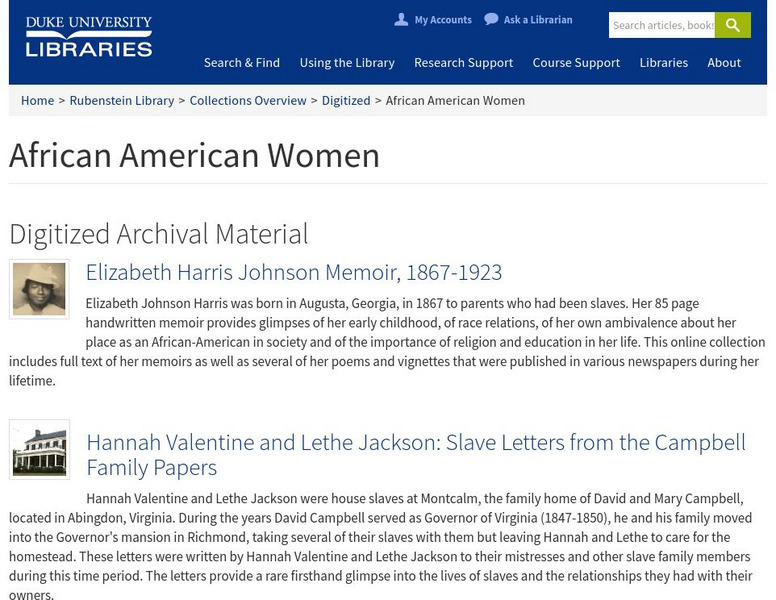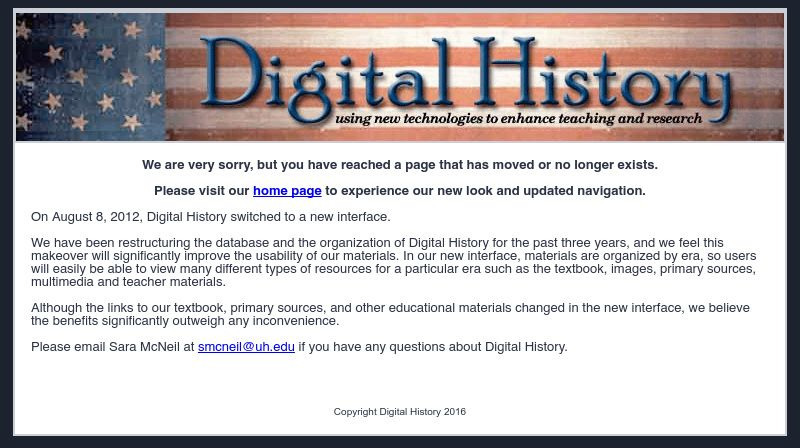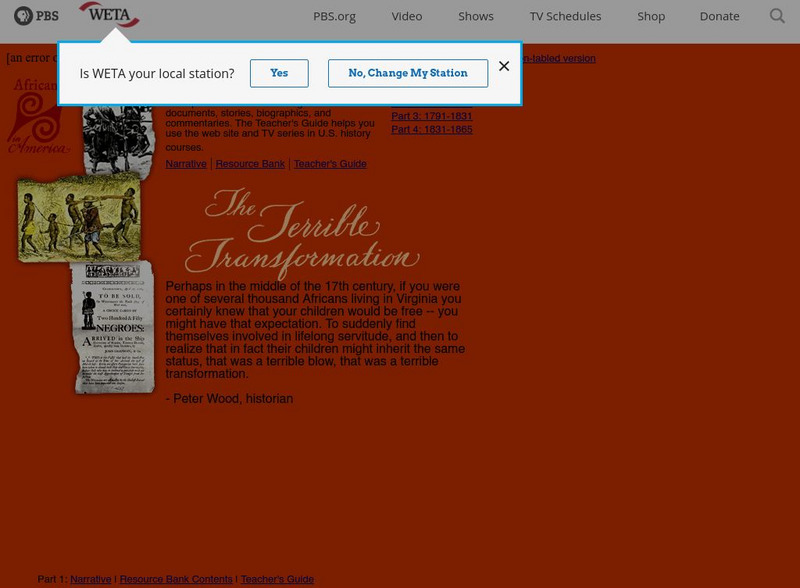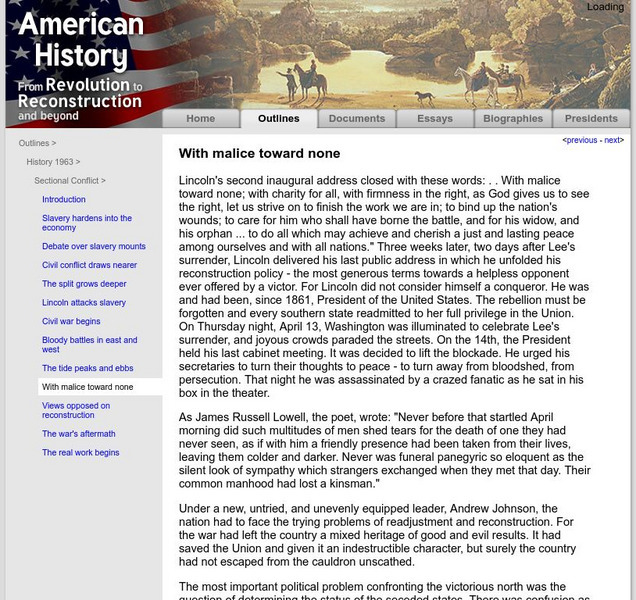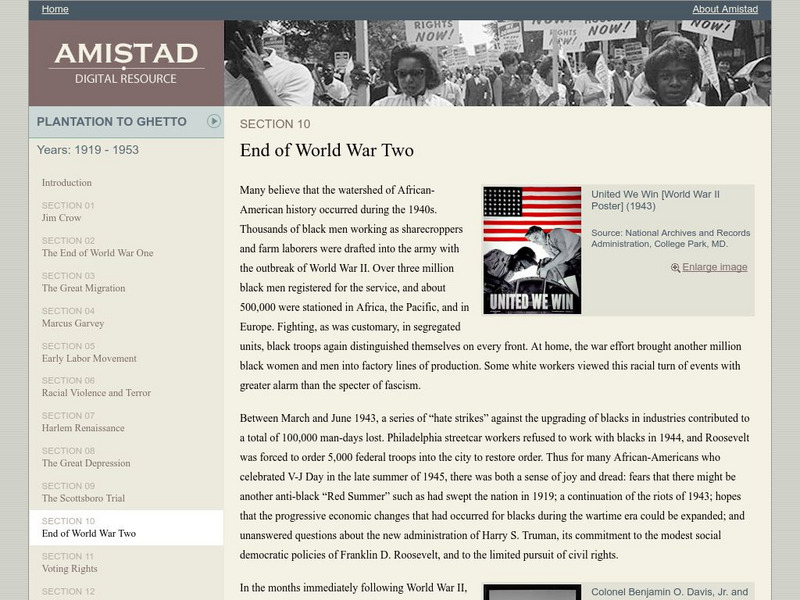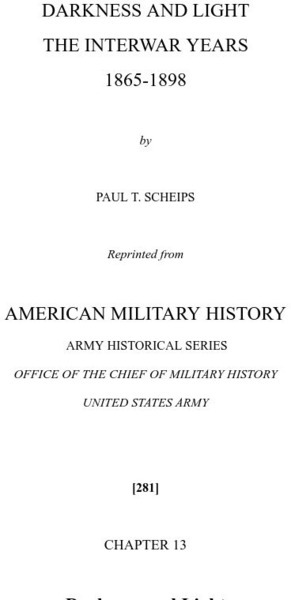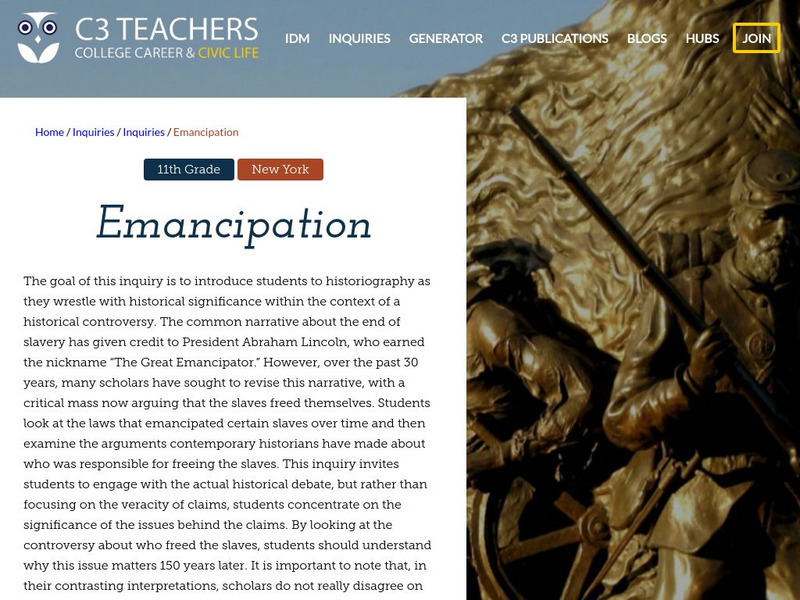Duke University
Duke University Libraries: Digitized Collections: African American Women
Access Civil War-era documents that give us a rare first-hand glimpse into the lives of African American women at the time: letters of two slave women from the 1830s and 1850s and a hand-written memoir of another woman born shortly after...
CommonLit
Common Lit: Assassination of the President:attempted Murder of Secretary Seward
This excerpt from an 1865 newspaper, Evening Star, contains multiple accounts of the night President Abraham Lincoln and Secretary of State William Seward were attacked. The attack came only five days after Confederate General Robert E....
PBS
Wnet: Thirteen: Slavery & Making of America: Imagining Freedom During/after Civil War
In this interactive game, students are presented with a political drawings and cartoons from the period 1860-1877, and they must choose which historical event related to the end of slavery best matches each image.
National Humanities Center
National Humanities Center: Toolbox Library: Emancipation, 1864 1865
Letters and narratives of slaves freed at the end of the Civil War. An interesting look at the confusion and eagerness which confronted these newly freed Americans.
The History Cat
The History Cat: African Americans After the War
Provides a discussion of what life was like for African Americans after slavery ended, focusing on the Freedman's Bureau, Freedman schools, and the Ku Klux Klan.
My Hero Project
My Hero: Clara Barton
Use this site to learn about the "Angel of the Battlefield," Clara Barton, who "helped find over 22,000 missing men" after the Civil War ended and founded the American Red Cross Association with some of her friends. Written by a student.
Other
Stephen Collins Foster: American Dreams
This site provides a wealth of information about the American songwriter, Stephen Foster. This link leads you to the biographical information which is divided into five sections: beginnings, his life's work, the legend, the problems, and...
Other
Afgen.com: Address to the Colored People
This page from Afgen.com contains the address delivered to the colored people at Galesburg, Illinois, 1867 by Robert G. Ingersoll. It emphasizes the rights of blacks as a result of the Civil War and Ingersoll encourages African-Americans...
A&E Television
History.com: How the South Helped Win the American Revolution
British commanders attempted to reverse their floundering fortunes by launching a campaign in the South. There the British would find not just crops such as tobacco, rice and indigo that were vital to their economy, but stronger Loyalist...
Digital History
Digital History: Pre Civil War American Culture: Introduction
A very brief look at the almost non-existent American culture at the end of the 18th century and leading in the the 19th.
Other
Bringing History Home: Segregation History
This 3rd grade unit introduces children to the history of segregation, from the end of the Civil War in 1865 through the 1940s. Its content bridges the period between slavery and the peak of the Civil Rights movement in the 1950s and...
PBS
Pbs: Africans in America
PBS offers a four-part series on the plight of African Americans from slave days to the end of the Civil War. Resources such as interactive maps, a Resource Bank, and Teacher's Guide are available.
University of Groningen
American History: Outlines: "With Malice Toward None"
A four-page discussion of Reconstruction from the plans Lincoln made while the Civil War was still raging to the end of Reconstruction with the election of Rutherford B. Hayes.
Siteseen
Siteseen: American Historama: Racial Segregation History in the United States
This article contains numerous facts about black segregation history in the United States from the Civil War through the end of the Civil Rights Movement.
US National Archives
Our Documents: Emancipation Proclamation (1863)
Image of handwritten copy of Lincoln's Emancipation Proclamation, accompanied by an explanation of the speech's purpose, impact, and role in American history.
Other
Slavery by Another Name
Read this detailed narrative to learn about the mistreatment of African Americans long after people thought slavery had ended after the Civil War, but actually persisted into the twentieth century. Based on original documents, photos,...
Other
Amistad Digital Resource: End of World War Two
Narrative explores the role of African Americans after World War II ended and the state of the civil rights movement from the 1940s to the early 1050s.
University of Maryland
Department of History: Freedmen and Southern Society Project
Collection of primary documents that depict the social revolution and drama of the Emancipation in the words of the participants. Includes the voices of liberated slaves and defeated slaveholders, soldiers and civilians, common folk and...
University of Richmond
Dsl: University of Richmond: Visualizing Emancipation
A map of slavery's end during the American Civil War. It finds patterns in the collapse of southern slavery, mapping the interactions between federal policies, armies in the field, and the actions of enslaved men and women on countless...
CommonLit
Common Lit: Text Sets: Reconstruction to Jim Crow
After the Civil War and end of slavery, Americans had to decide how to integrate freed African Americans. Learn about the lives of African Americans from Reconstruction to the end of the prejudiced Jim Crow era. This collection includes...
Khan Academy
Khan Academy: Ap Us History: 1865 1898: The American West: Reservation System
Discusses the Indian reservation system, the impact it had on Native Americans, violent clashes between whites and Indians, and how it was destroyed by the Dawes Act of 1887 and resurrected in the 1930s. Includes questions for students...
US Army Center
U.s. Army Center of Military History: Darkness and Light, the Interwar Years 1865 1898
This resource offers a good look at the reorganization and use of the U.S. military in the years betwee the end of the Civil War and the Spanish-American War.
C3 Teachers
C3 Teachers: Inquiries: Emancipation
A learning module on the emancipation of African American slaves after the Civil War. It includes several supporting questions accompanied by formative tasks and source materials, followed by a summative performance task. Students will...
University of Groningen
American History: Outlines: The Era of Expansion and Reform
This resource, a speech by Woodrow Wilson to Congress on April 8, 1913, gives a great review of how the United States transformed from from a rural country to an urban one. It includes a review of industrialization, new inventions,...


